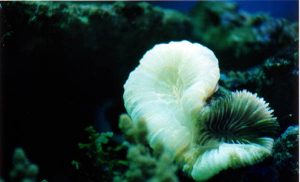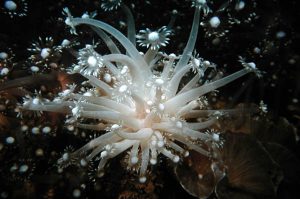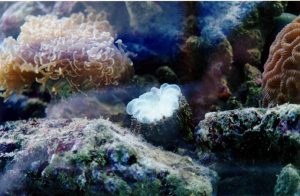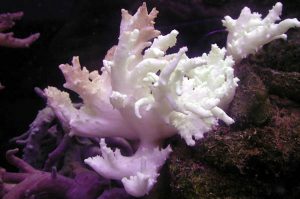Many of the questions I am asked have an “ailing” coral as the subject. Often, the problem involves some amount of paling to the normal coloration of a coral, or a visible white area on the coral. It is very difficult to ascertain the nature of the problem under any circumstances, but one of the most common mistakes is the misidentification of coral bleaching. In the next few articles, I intend to look at some of the causes, appearance, and effects of bleaching and then, in subsequent articles, a group of problems of various types characterized by actual tissue loss. These events can be difficult to tell apart, may have similar or different causes and effects, and may even be related to each other.

Trachyphyllia geoffroyi is often susceptible to bleaching in aquariums. Part of the reason may stem from the fact that many of the bright colored (red and green) specimens are being collected in deep water. The coral above has bleached, and is showing signs of tissue loss, probably from starvation resulting from the loss of zooxanthellae.
Background
What is bleaching? Bleaching occurs in corals that maintain a symbiosis with various types of dinoflagellates called zooxanthellae. By one common definition, bleaching is the release, rejection, or loss of zooxanthellae from coral tissue.
Zooxanthellae are acquired by corals in two ways: first, they may be given a “starter culture” by the parent if the parent colony broods its planulae. Alternately, in corals that release sperm and eggs into the water and where fertilization takes place externally in the water column, planulae (lacking zooxanthellae) can swallow the algae from the water column. Once swallowed, the algae are not digested but are brought into the cell and put into a small intracellular bag called a vacuole. Once inside the vacuole, they are “trapped” and somewhat at the mercy of the coral polyp. The golden brown algae reproduce within the cell and form a dense, but very thin layer within the polyp. The zooxanthellae are found mainly in the inner

The Goniopora shown is bleached. The tissue is transparent, indicating a dramatic loss in zooxanthellae. This coral is probably not bleached from excess radiation or temperature, as it was photographed in deep water where light levels are low and temperature is relatively constant.
tissue layer of corals called the gastroderm, although they can occasionally be found in the outer layer (ectoderm) and are in the tentacles of day-feeding corals. Night feeding corals have transparent tentacles that normally lack zooxanthellae.
Once inside the polyp, zooxanthellae are provided nutrients that are controlled, and usually limited, by their host. In return, the algae use sunlight to photosynthesize and provide the
energy rich products of photosynthesis (photosynthate) to the coral polyp. The nutrients for the zooxanthellae are mainly the products of coral metabolism; that is, carbon dioxide and
nitrogen.
One of the advantages to living within polyp tissue is that zooxanthellae have constant access to nitrogen in the form of coral metabolic waste products. In contrast, the usually nitrogen
deficient seawater may not be able to provide a plentiful source of nitrogen for growth and reproduction. However, the coral can and does control the amount of waste released intracellularly to the zooxanthellae, excreting any excess back into the seawater. Under normal conditions, the balance is very precise and there is very little deficiency or excess, with virtually all of the coral’s metabolic waste consumed by a precisely moderated population of zooxanthellae.
Bleaching Variation
Conditions can occur, however, that change the balanced symbiosis of algae and coral. Where there is chronic or acute nutrient limitation, the coral may not produce enough waste to sustain the zooxanthellae. Conversely, the zooxanthellae will not be able to produce enough photosynthate to sustain the coral. If the deficiency is great enough, the zooxanthellae density will be reduced. This can happen in three ways: the zooxanthellae will simply die and be ejected from the coral; the coral can digest the zooxanthellae for its own energy needs (if it is a species that can digest plant material, specifically cell wall components); or the coral can release some of the zooxanthellae from its tissues back into the water. This is bleaching.

This Cynarina lacrymalis is severely bleached. The tissue is clearly visible and inflated, although without the pigmentation of zooxanthellae. The white coloration comes from the skeleton visible under the tissue. This coral will probably need to capture prey or be fed to prevent starvation and recovery of a full complement of zooxanthellae.
Similarly, although for different reasons, chronic or acute excess of nutrients (especially nitrogen) can also cause bleaching. Since corals can absorb dissolved nutrients directly from seawater, they can benefit from energy obtained in this way. However, when dissolved nitrogen is absorbed into the tissue and cells, the zooxanthellae can also have access to the material. In this case, there may be an excessive nutrient availability and the zooxanthellae are less nutrient limited by the coral, and can use the nitrogen to grow and reproduce. The growth to higher densities of zooxanthallae is not necessarily good for the coral, and the growth can become unbalanced and unchecked. If this happens, bleaching may be required to maintain proper densities of algae within the tissues.
Zooxanthellae also have finite life spans, and at any time there are numbers of them that become senescent and are no longer useful to the polyp. These zooxanthellae are ejected, and this is also a form of bleaching.
The descriptions above sound like adaptive and productive behavior involved in maintaining a balanced symbiosis, and they are. So bleaching, by definition, is not necessarily a detrimental occurrence as is widely held. However, there are degrees of bleaching, and there are other factors that can cause bleaching. These are cases where bleaching is not a normal regulatory mechanism, but are caused by various factors that not only jeopardize the symbiosis, but the health of each partner.
Another Definition of Bleaching
Coral bleaching has another and more popularly conceived definition. This definition states that a coral is considered bleached when there is a visible lightening of the normal coloration state, translating to an approximate loss of 50% of the standing stock of zooxanthellae. Most people associate a bleached coral with the images of stark white corals on a reef. This is considered to be severe bleaching, with mass bleaching defined as when an entire community of corals has become partly or totally bleached.
When I say totally bleached, this is a bit of an overstatement. There are, to my knowledge, no cases reported where bleaching is total except in experimental conditions (difficult to even achieve) and where some temperate corals can exist naturally either with or without zooxanthellae. The densities of zooxanthellae, at most, become extremely low so that their brownish coloration is no longer visible and the coral tissue becomes largely transparent, revealing the white skeleton below.
Mechanisms and Effects of Bleaching
The low numbers of zooxanthellae remaining in bleached coral tissue are also the reason that bleached corals often recover. It is unlikely that they recover to an appreciable extent by acquisition from the water column, but rather from the reproduction of those left in the tissue. However, if zooxanthellae densities are extremely low, the coral cannot get much energy from the products of their symbiotic algal’s
photosynthesis. This creates an energy deficit that must be filled by either feeding or by direct uptake of nutrients from seawater. While possible, severely bleached corals often do not recover, and they die. Why?

The Sinularia sp. pictured here is bleached, although zooxanthellae are still visible in some of the branches on the left.
Seawater is often nutrient poor, and so direct absorption may not take place to a degree, or at a rate, that can provide enough nutrition. Secondly, even if there are adequate prey items for the coral to capture, the maintenance of capture mechanisms, such as nematocysts, are energetically costly. The coral may not be able to effectively maintain these structures and, therefore, be unable to effectively feed. Furthermore, it costs energy to swallow and digest prey items. For aquarists, this is readily obvious in bleached corals that appear to have no interest or ability to capture food items offered to them. In the end, bleached corals operating at an energy deficiency must metabolize their own tissues to survive, and this is seen as recession and tissue death. It is also called starvation.
The best solution to a severe bleaching event, beyond removing the stressors that caused the bleaching in the first place, is to provide enough nutrients to sustain the coral and to repopulate zooxanthellae, as well as providing them in a form that requires the least amount of energy to obtain and use. The best answer for all of these requirements is to make sure that there is a good supply of dissolved nitrogen in the water column. A high nitrogen level will probably not be beneficial once a bleached coral recovers, but it can be helpful in the recovery process. Bingman correctly notes that many aquariums are already many times higher than reefs in usable forms of nitrogen (pers. comm.). In such cases, increasing the usable forms of nitrogen (nitrate and ammonium) will probably not matter. However, many aquarists now keep aquariums where nitrogen levels approach or are below average reef water levels, and in such cases ammonium or nitrate can be fuel for zooxanthellae reproduction. For further information on the role of nitrogen in zooxanthellae reproduction, see Marubini and Davies (1996), Hoegh-Guldberg (1994), Hoegh-Guldberg and Smith (1989), and Mueller-Parker et al. (1994).
Another problem that occurs with bleaching is the way in which zooxanthellae are lost. Aquarists may be familiar with brown mucous strands of zooxanthellae being released from the mouth of a coral. Often, zooxanthellae removal or loss is a fairly controlled process with the vacuoles containing the algal cells moving towards the outer cell membrane, fusing with it, and then releasing the contents into the coelenteron. However, rapid bleaching or severe stress results in a much more detrimental release, with the entire cell contents being blown out into the coelenteron or, even more severely, the entire dermal cell being detached and lost. It should be apparent that such traumatic reactions have an even greater detrimental effect on a coral than the loss of algal cells alone. In such cases, bleaching is often severe enough and with enough concomitant injury that recovery chances are slim.
Corals bleach for a number of reasons, some of which were described above as regulatory processes. In more detail, the quantity and quality of photosynthetic products is a major factor. In particular, the production of oxygen by zooxanthellae can be especially problematic. Excess oxygen, especially in forms where singlet oxygen radicals are produced, or when coupled with water to form hydrogen peroxide, can be damaging to coral tissue. Corals do produce enzymes to detoxify these oxygen forms, but under conditions that produce bleaching, they may not be able to handle the amount of oxygen produced. Therefore, bleaching occurs to prevent the oxygen poisoning of the coral cells.
It is not well known yet if bleaching is ultimately under coral or zooxanthellae control. There is evidence to support both views, and perhaps various bleaching events depending on the circumstances, may be under the control of both or either partner(s). Further research is required to determine these and other aspects of the bleaching response.
Other Aspects of Bleaching
The factors that can cause coral bleaching are numerous. In the wild, the most established factor attributed to mass bleaching events is a prolonged increase in temperature above normal levels. Temperature as a bleaching cause may be synergistic with other factors, including reduced water motion, irradiance, and nutrients. A list of factors shown to cause bleaching in various studies are:
- Bacterial bleaching – Vibrio shiloi
- Low light or darkness
- Chemicals – pollutants, metals, pesticides, contaminants
- Endolithic fungii
- Ciliates – unknown type and role
- Hyper salinity
- Coccideans – unknown type and role
- Hypo salinity
- High temperature – sustained or short-term increase
- Drugs
- Low water motion (stagnant water, doldrums)
- Competition
- High irradiance – sustained or a rapid increase
- Sedimentation
- Ultraviolet radiation – sustained high levels or a rapid increase
- Starvation
- Rapid change in temperature – higher or lower
- Physical injury or stress
“But my coral still has a light blue color,” queries an aquarist, “it must not be bleached.” Untrue! Many of the bright colors found in corals are due to fluorescing proteins that are not apart of the zooxanthellae. These pigment complexes lie in vesicles either above or below the zooxanthellae within the animal tissue. They serve to modulate visible and ultraviolet light in either enhancing or protecting roles. If zooxanthellae are lost, these pigments can remain for quite some time. Because they are no longer serving their function and they are metabolically costly to produce, these pigments will eventually be lost until they are required again. If there is recovery they will be produced again by the recovered coral if required. But, it takes some time for them to be metabolized (unless the bleaching event resulted in the entire loss of cellular contents or cell detachment), and so a coral may retain some colorful pigmentation even when bleached of zooxanthellae almost completely.
Conclusions and Notes for Aquarists:
In conclusion, bleaching is a common event in both wild and aquarium corals. In many cases, minor bleaching may not even be noticed, with zooxanthellae and coral pigments occurring in high enough densities to prevent observation. When bleaching becomes severe enough, a paling or transparency of coral tissue results and the coral presents a resulting pale or white appearance.
When this occurs, it can be very difficult to assess whether or not coral tissue remains. In some cases, tissue expansion can be apparent and it is obvious that there is coral tissue remaining, but that it is transparent. In other cases, and especially when a stressor is still present, coral tissue may not expand, or be reduced in mass, and remains tightly contracted. It is then very difficult to determine if there is coral tissue remaining, or if tissue loss has occurred. One of the fastest ways to assess this is to watch for the rapid colonization of diatoms and other algae. These algae will not settle on coral tissue, but readily populate exposed skeleton and should be visible to the eye within a day or so after skeletal exposure. However, this too can be deceiving. Sometimes, bleached coral tissue was present but then died as a result of the bleaching, and the skeleton is now exposed. Also, recovery from bleaching can sometimes occur quickly, and the recovering and reproducing brown zooxanthellae within the tissue can be mistaken for diatoms and other brown algae on exposed skeleton. Conversely, brown diatoms are often mistaken for zooxanthellae recovery. Furthermore, initial populations of diatoms are soon replaced by other algae, many of which may be unicellular green types that frequently give aquarists the false impression of recovery. Aquarists often report that their coral is recovering because they see a greenish color returning to the tissue, but it is often just green algae growing on exposed skeleton.
Whether or not a coral recovers from bleaching is mostly a factor of the subsequent conditions following the bleaching event and the severity of the bleaching itself. There are no hard and fast rules to determine whether or not a coral will recover, and time is often the only indication and cure. Because a coral appears white, however, does not necessarily indicate that bleaching has occurred. The same signs of a pale or white coral can also be indicative of tissue recession, competition, predation, environmental stress, and disease. Despite the difficulty of always being able to recognize bleaching, it is the till the easiest of these “white” coral problems to identify. In the next article, I will discuss some of the other causes of “white” corals and their recognition in aquariums.
Websites with further information on coral bleaching:
- http://www.state.gov/www/global/global_issues/coral_reefs/990305_coralreef_rpt.html
- http://www.aims.gov.au/pages/search/search-coral-bleaching.html
- http://www.greenpeaceusa.org/media/publications/coral_bleaching.htm
- http://www.coral.noaa.gov/glynn/index.html
- http://www.gbrmpa.gov.au/corp_site/info_services/publications/reef_research/issue2_98/2rmn1.html
- http://www.reef.crc.org.au/aboutreef/coral/coralbleaching.shtml
Literature Used
(not exhaustive, but useful for anyone interested in aspects of coral bleaching, and including excellent summary papers):
- Brown, B. (1997). “Coral bleaching: causes and consequences.” Proceedings of the 8th International Coral Reef Symposium, Panama.
- Brown, B. E. (1995). “Mechanisms of bleaching deduced from histological studies of reef corals sampled during a natural bleaching event.” Marine Biology 122: 665-663.
- Brown, B. E. and L. S. Howard (1985). “Assessing the effects of ‘stress’ on reef corals.” Advances in Marine Biology. London, Academic Press, Inc. 22: 1-63.
- Brown, B. E. and M. Le Tissier (1992). “Quantification of coral bleaching.” Proceedings of the Seventh International Coral Reef Symposium, Guam, University of Guam Press.
- Bunkley Williams, L. and E. H. J. Williams (1988). “Coral reef bleaching: current crisis, future warning.” Sea Frontiers (March-April): 81-87.
- Fagoonee, I., H. B. Wilson, et al. (1999). “The dynamics of zooxanthellae populations: a long-term study in the field.” Science 283(5 February 1999): 843-845.
- Fitt, William K., et al. 2001. “Coral bleaching: interpretation of thermal tolerance limits and thermal thresholds in tropical corals.” Coral Reefs 20: 51-65.
- Fitt, W. K., H. J. Spero, et al. (1993). “Recovery of the coral Montastrea annularis in the Florida Keys after the 1987 Caribbean “bleaching event.” Coral Reefs 12: 57-64.
- Gates, R. D., G. Baghdasarian, et al. (1992). “Temperature stress causes host cell detachment in symbiotic cnidarians: implications for coral bleaching.” Biological Bulletin 182: 324-332.
- Glynn, P. W. and L. D’Croz (1990). “Experimental evidence for high temperature stress as the cause of El Nino-coincident coral mortality.” Coral Reefs 8: 181-191.
- Harriott, V. J. (1985). “Mortality rates of scleractinian corals before and during a mass bleaching event.” Marine Ecology Progress Series 21: 81-88.
- Hoegh-Guldberg, Ove. 1999. “Climate change, coral bleaching and the future of the world’s coral reefs.” Mar. Freshwater Res. 50: 839-866
- Hoegh-Guldberg, Ove. 1994. “Population dynamics of symbiotic zooxanthellae in the coral Pocillopora damicornis exposed to elevated ammonium {(NH4)2SO4} concentrations.” Pac Sci 48: 263-72.
- Hoegh-Guldberg, Ove, and G. Jason Smith. 1989. “Influence of the population density of zooxanthellae and supply of ammonium on the biomass and metabolic characteristics of the reef corals Seriatopora hystrix and Stylophora pistillata.” Mar Ecol Prog Ser 57: 173-86.
- Hoegh-Guldberg, O., L. R. McCloskey, et al. (1987). “Expulsion of zooxanthellae by symbiotic cnidarians from the Red Sea.” Coral Reefs 5: 201-204.
- Hoegh-Guldberg, O. and G. J. Smith (1989). “The effect of sudden changes in temperature, light and salinity on the population density and export of zooxanthellae from the reef corals Stylophora pistillata Esper and Seriatopora hystix Dana.” Journal of Experimental Marine Biology and Ecology 129: 279-303.
- Kleppel, G.S., R.E. Dodge, and C.J. Reese. 1989. “Changes in pigmentation associated with the bleaching of stony corals.” Limnol Oceanogr 34: 1331-5.
- Kushmaro, A., Banin, E., Stackebrandt, E., and Rosenberg, E. (2001) “Vibrio shiloi sp. nov: the causative agent of bleaching of the coral Oculina patagonica.” Int J Sys Evol Microbiol 51: 1383-1388.
- Marubini, F., and P.S. Davies. 1996. “Nitrate increases zooxanthellae population density and reduces skeletogenesis in corals.” Mar Biol 127: 319-28.
- Muller-Parker, G., et. al. 1994. “Effect of ammonium enrichment on animal and algal biomass of the coral Pocillopora damicornis.” Pac Sci 48: 273-83.




i hope you can help me i have acros that come in brown from wherever i order them it look like there skin when i put some poly lab on them it blew the skin off turned all white i also had a strawberry acro frag 3 days later it turned white pure white and i lost another one early now here is the thing same thing last year i lost all bottom corals as wellm as acro’s i went for 3500.00 dollars i need help all of this went from say lfs boxed no light in a box thrown in a fdx or ups truck then it goes to the main office then it gets split sent to different areas and then thrown into onother truck and hope you get to it sooner then later